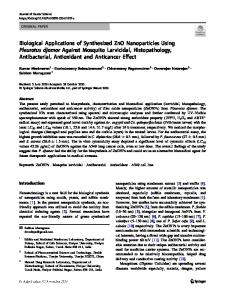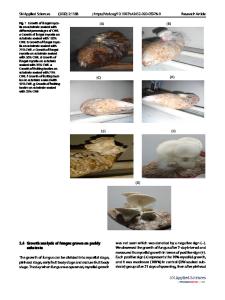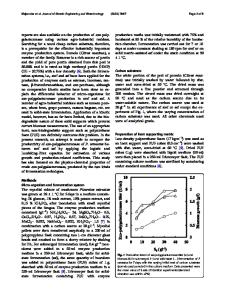Effect of Extraction Processes on Bioactive Compounds from Pleurotus ostreatus and Pleurotus djamor : Their Applications
- PDF / 2,336,774 Bytes
- 13 Pages / 595.276 x 790.866 pts Page_size
- 54 Downloads / 291 Views
Effect of Extraction Processes on Bioactive Compounds from Pleurotus ostreatus and Pleurotus djamor: Their Applications in the Synthesis of Silver Nanoparticles Héctor Eduardo Martínez‑Flores1 · Rafael Contreras‑Chávez1 · Ma. Guadalupe Garnica‑Romo2 Received: 12 August 2020 / Accepted: 11 November 2020 © Springer Science+Business Media, LLC, part of Springer Nature 2020
Abstract The objective of this study was to obtain bioactive compounds from extracts of Pleurotus ostreatus and Pleurotus djamor to be used as reducing agents in the synthesis of silver nanoparticles (AgNPs). The mushrooms were dried using two methodologies: solar dehydration and cabinet oven dryer. Two procedures were applied to extract bioactive compounds from the fresh and dehydrated Pleurotus spp. In the first, maceration was applied at 25 °C using water and ethanol at different concentrations with stirring for 48 h. In the second, extractions were carried out by boiling for 2 h using Soxhlet equipment. Total phenolic compounds, flavonoids and anthocyanins, and ascorbic acid were determined. Antioxidant capacities were quantified by ABTS and DPPH methods. For both species, the extract obtained by maceration with 100% water, and dried in the solar dehydrator exhibited the highest antioxidant activities. The extracts were used in the synthetic reactions of AgNPs, using a suspension of 3 mM silver nitrate. The AgNPs were oven-dried at 100 ºC and calcined to obtain a powder that was characterized by X-ray diffractometry and scanning electron microscopy, obtaining AgNPs with an average particle size of 28.44 nm for P. ostreatus and 55.76 nm for P. djamor.
* Ma. Guadalupe Garnica‑Romo [email protected] 1
Facultad de Químico Farmacobiología, Universidad Michoacana de San Nicolás de Hidalgo, Tzintzuntzan 173, Col. Matamoros, 58240 Morelia, Michoacán, Mexico
Facultad de Ingeniería Civil, Universidad Michoacana de San Nicolás de Hidalgo, Santiago Tapia 403. Col. Centro, 58000 Morelia, Michoacán, Mexico
2
13
Vol.:(0123456789)
Journal of Inorganic and Organometallic Polymers and Materials
Graphic Abstract
Keywords Green synthesis · Pleurotus ostreatus · Pleurotus djamor · Silver nanoparticles
1 Introduction Nanotechnology is one of the most promising research areas due to the interest in using techniques to synthesize and characterize materials, and devices with industrial applications on a nanometric scale. Silver is a metal that is quite useful for producing nanoparticles. Silver nanoparticles (AgNPs) have been used because of their attractive properties in different areas, such as: chemical catalysis [1], biosensing to detect molecules [2], drug delivery vehicles [3, 4], and agents with antibacterial, antiviral, or fungicidal activities [5, 6], among others. Some studies have shown the potencies of AgNPs to inhibit microbial growth or kill microorganisms, such as: Candida albicans, Saccharomyces cerevisiae, Escherichia coli, Pseudomonas aeruginosa, Bacillus subtilis, and Staphylococcus aureus These AgNPs were synthesized using a
Data Loading...











